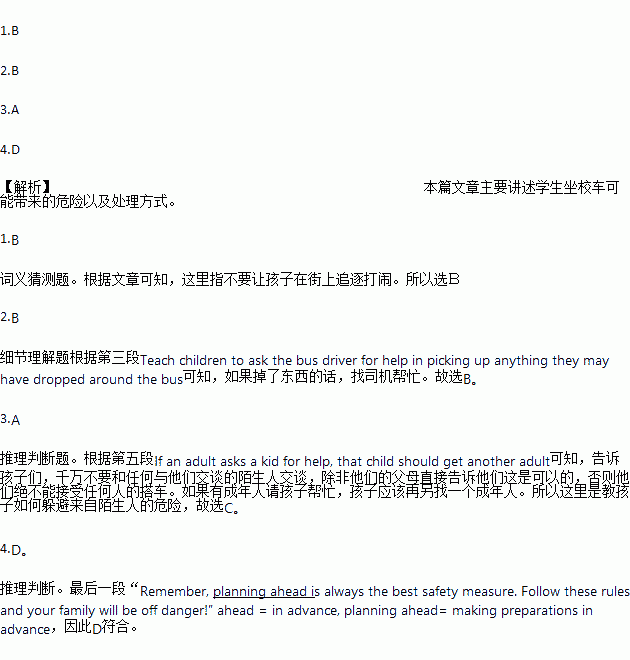题目内容
Getting on the school bus, like the possible dangers around the home, getting on the school bus can also bring its own set of dangers. There are several important safety measures that parents should be aware of when it comes to bus safety.
Parents should always make sure that someone is taking charge of children at the bus stop to make certain clear ground rules which are in place and are being followed—particularly rules that forbid horseplay in and around the street.
Teach children to ask the bus driver for help in picking up anything they may have dropped around the bus, as children getting dropped articles are often hit by the bus or another vehicle because they are not seen by the bus driver or by oncoming traffic.
Children should be asked to take five large steps away from the bus when they get it off, and make sure that the bus driver can see you and look you directly in the eyes to signal it is OK to cross the street. It is still very important that children also look both ways as they cross the street.
Inform children that they must never speak to any stranger who talks with them first and that they must never accept a ride from any person unless their parents tell them directly that it is OK. Teach kids that adults should ask other adults for help, not kids. If an adult asks a kid for help, that child should get another adult.
If for any reason a child feels uncomfortable or unsafe at the bus stop they need to bring it to a parent’s or caregiver’s attention.
Remember, planning ahead is always the best safety measure. Follow these rules and your family will be off danger!
1.The underlined word “horseplay” in Paragraph 2 has the similar meaning as__________.
A. stay in order
B. chase each other
C. play game on horse
D. ride a horse around
2.Which of the following should a child do when his book falls around the bus?
A. Pick it up quickly by himself.
B. Turn to the bus driver.
C. Keep silent without telling others.
D. Ask other children for help.
3.What is the main point of Paragraph 5?
A. It’s about tips on how to avoid dangers from strangers.
B. It’s about tips on how to deal with strangers on the road.
C. It’s about tips on how to escape from dangerous strangers.
D. It’s about tips on how to refuse to talk with strangers.
4.The best way to make your children safe is__________according to the passage.
A. warning them of various dangers
B. asking them to go to school by bus
C. sending them to school yourself
D. making preparations in advance

